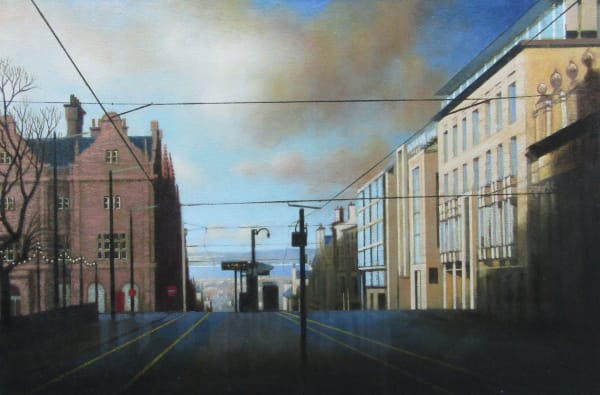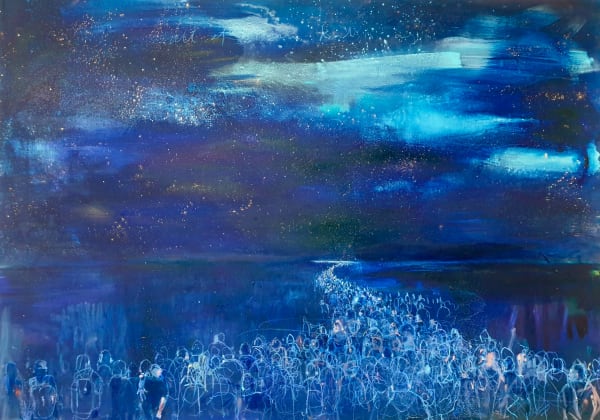In This Guide:
The moment you encounter a masterful painting, time seems to pause. Whether it's the rich impasto of an oil painting catching gallery light or the delicate transparency of a watercolour that seems to glow from within, painting art possesses an immediacy and emotional power that speaks directly to the soul. Yet for many gallery visitors, the variety of painting styles and mediums can feel overwhelming. What distinguishes an oil painting from an acrylic? How do you recognise different painting styles? What makes Scottish painting unique?
This guide provides clear, accessible explanations of painting art as it appears at Graystone Gallery, helping you recognise, understand, and appreciate the diversity and craftsmanship of contemporary Scottish painting. By understanding the mediums, techniques, and traditions that shape painting art, you'll develop the confidence to connect with artworks and artists on a deeper level, transforming gallery visits from uncertain browsing into meaningful encounters with artistic expression.
Whether you're considering your first painting purchase or seeking to deepen your appreciation of works you already own, this collector's guide will enhance your understanding of painting as both craft and art.
-
 Rosanne BarrOil on canvasLighthouse IslandUnframed Size: 30 x 30 cm
Rosanne BarrOil on canvasLighthouse IslandUnframed Size: 30 x 30 cm -
Types Of Painting Mediums
The choice between oil, acrylic, and watercolour fundamentally shapes a painting's character, affecting everything from working methods to final appearance and longevity. Each medium offers distinct advantages and challenges, influencing why artists select particular approaches for specific artistic goals.
Oil Paintings
Oil paintings have dominated fine art for centuries due to their unmatched colour depth and remarkable working properties. Oil paint consists of pigment suspended in oil, typically linseed, creating a medium that dries slowly and allows for extended manipulation. This slow drying time enables artists to achieve seamless colour blending, subtle gradations, and the building up of rich, textured surfaces through techniques like impasto (a painting technique where paint is applied thickly, creating visible texture and depth through bold brushstrokes or palette knife marks).
Oil paintings characteristically exhibit deep, luminous colours that seem to glow from within. The medium's capacity for both transparent glazes and opaque applications allows artists to create complex colour relationships and atmospheric effects. You can often identify oil paintings by their slight glossy sheen once varnished and the visible texture of brushstrokes that remain permanently recorded in the dried paint surface.
The slow drying nature of oils allows artists to work over days or weeks on a single passage, reworking areas until achieving the desired effect. This working method suits contemplative approaches and enables the fine modelling of forms that characterises much traditional painting. Contemporary oil painters like Louis McNally demonstrate how this traditional medium continues to serve modern artistic vision.
Acrylic Paintings
Acrylic paintings represent modern innovation in painting mediums, offering versatility and convenience whilst maintaining artistic integrity. Developed in the mid-20th century, acrylic paint consists of pigment in acrylic polymer resin that dries rapidly through water evaporation, allowing artists to work quickly and build layers without extended waiting periods.
Acrylics can be thinned with water to achieve watercolour-like transparency or used thickly to mimic oil paint effects. However, the medium possesses its own character: acrylic colours often appear particularly vibrant and can achieve crisp, hard edges that suit contemporary graphic approaches. The rapid drying prevents the extended blending possible with oils but enables quick layering and immediate overpainting.
You can identify acrylic paintings by their often matte appearance (unless varnished) and sometimes more uniform colour areas. Under close examination, acrylic paint may appear slightly plastic-like when thick, and thin applications often show very even, flat colour fields. Many contemporary artists choose acrylics for their bright colour potential and quick working properties.
Watercolour Paintings
Watercolour paintings captivate viewers with their characteristic luminosity and spontaneous, fluid character. The medium consists of pigment mixed with water, typically applied to paper, where the white surface shows through transparent washes to create the painting's lightest values and overall brightness.
Watercolour demands confident execution because the medium's transparency makes correction difficult. Heavy overworking can muddy the clear, fresh appearance that makes watercolour so appealing. Artists exploit the medium's natural fluidity to create atmospheric effects, soft edges, and the happy accidents that occur when wet paint flows and mingles on paper.
Watercolour paintings are almost always presented matted under glass for protection, and their delicate, often ethereal appearance immediately distinguishes them from oil or acrylic works. The medium excels at capturing fleeting effects of light and atmosphere, making it particularly suitable for landscape painting and quick, impressionistic studies.
-
 Madeleine GardinerOil on canvasShallows, SkyeFramed Size: 29 X 34 cm
Madeleine GardinerOil on canvasShallows, SkyeFramed Size: 29 X 34 cm -
Scottish Painting And What Makes It Unique
Scottish painting possesses a distinctive character shaped by the nation's dramatic landscapes, unique light conditions, and cultural heritage, whilst maintaining dialogue with international artistic movements. This balance between local authenticity and global awareness has produced a painting tradition that speaks with a recognisably Scottish accent whilst addressing universal themes.
The influence of Scotland's geography appears throughout its painting tradition. The country's varied landscapes, from Highland mountains to coastal seascapes, provide endless inspiration whilst the distinctive quality of Scottish light, particularly the long twilight hours and dramatic weather changes, influences how artists approach colour and atmosphere.
The Scottish Colourists established the foundation of modern Scottish painting through their bold use of colour and Post-Impressionist techniques. Artists like Samuel Peploe and Francis Cadell brought French influences back to Scotland but adapted them to local subjects and sensibilities, creating works that balanced international sophistication with Celtic directness and love of strong, expressive colour.
Contemporary Scottish painters continue this tradition of balancing innovation with respect for place. Many work with themes that reflect Scottish experience whilst employing techniques and concepts drawn from global contemporary art practice. This synthesis creates painting that feels authentically Scottish whilst engaging with broader artistic conversations.
Scottish painting also reflects the nation's cultural values: a preference for directness over pretension, respect for craft skills, and appreciation for both intellectual rigour and emotional authenticity. These characteristics appear in how Scottish artists approach their materials, their willingness to combine traditional techniques with contemporary concerns, and their commitment to excellence in execution.
-
Art by the Artists in this Article
-
Featured Painters At Graystone Gallery
Our collection represents the breadth and quality of contemporary Scottish painting, featuring artists who demonstrate both technical mastery and distinctive artistic vision. Each painter brings their unique perspective to the medium whilst contributing to the ongoing evolution of Scottish art.
Christine Clark exemplifies contemporary painting's capacity to combine traditional techniques with modern sensibility. Her paintings demonstrate mastery of colour relationships and compositional structure whilst addressing themes relevant to contemporary experience.
Louis McNally represents another approach to contemporary painting, exploring how traditional painting techniques can serve contemporary artistic vision. His work shows how respect for craft traditions can support rather than limit innovative artistic expression.
Margaretann Bennett RSW brings the perspective of an artist deeply engaged with Scottish artistic institutions whilst maintaining an individual artistic voice. Her membership in the Royal Scottish Society of Painters in Watercolour reflects both her technical accomplishment and her contribution to Scottish painting tradition.
Meet all our painters and discover their unique approaches
-
How Are Paintings Appreciated & Valued?
Developing your ability to appreciate paintings involves training your eye to notice technical elements whilst remaining open to emotional and intellectual responses. Professional art appreciation combines systematic observation with personal engagement, creating a deeper understanding of both craft and meaning.
Begin with careful observation of brushwork and paint application. Notice whether brushstrokes are smooth and nearly invisible, suggesting academic training or deliberate refinement, or bold and expressive, conveying energy and emotion. Thick paint application (impasto) creates texture and demonstrates the artist's physical engagement with the medium, whilst thin, carefully controlled applications might suggest patience and precision.
Examine compositional choices and how they guide your visual experience. Consider where your eye enters the painting and how the artist directs your attention through the arrangement of shapes, colours, and lines. Strong compositions create visual pathways that enhance the painting's impact and help communicate the artist's intentions.
Pay attention to colour relationships and their emotional effects. Warm colours typically advance and energise, whilst cool colours recede and calm. Artists use these natural responses to create mood and direct attention. Notice whether the artist uses colour naturalistically or expressively, and how colour choices support the painting's overall character.
Consider the artist's technical choices in service of their artistic goals. A precisely rendered realistic painting demonstrates different intentions than a loosely handled expressive work, but both approaches can achieve artistic success when technique serves vision. Understanding why an artist might choose a particular approach deepens appreciation of their achievement.
Trust your emotional responses whilst developing analytical skills. The most important aspect of art appreciation remains your personal connection to the work. Technical understanding should enhance rather than replace this emotional engagement, providing vocabulary to articulate why certain paintings move you.
-
-
Frequently Asked Questions
How to identify a good painting?
Quality in painting appears through technical competence, artistic vision, and successful execution of the artist's intentions. Look for confident brushwork, thoughtful composition, effective use of colour, and evidence that the artist has something meaningful to express. A good painting should reward extended viewing, revealing subtleties that weren't immediately apparent.
How do you clean paintings?
Painting conservation requires professional expertise for anything beyond gentle dusting. For routine maintenance, use a soft, dry brush to remove surface dust, working from top to bottom. Never use water, household cleaners, or cloths on painted surfaces, as these can cause irreversible damage. For more detailed guidance, see our comprehensive care guide.
How to hang paintings?
Proper hanging enhances both the painting's impact and its preservation. Use appropriate hardware for the work's weight, hang at eye level (centre of the painting at 145cm from floor), and ensure adequate lighting without direct sunlight. Our detailed hanging guide provides comprehensive advice on placement and display.
How to find the perfect painting?
Finding the right painting involves balancing personal response with practical considerations. Start by identifying what moves you emotionally, then consider how the work will fit your space and lifestyle. Don't rush, live with your choice mentally before purchasing. Our complete art buying guide helps you navigate the selection process with confidence.
This guide was co-created in collaboration with Emile Haffmans of Art World Marketing and Finn Theunis of Orys in order to provide comprehensive and practical advice for understanding art forms and mediums.






